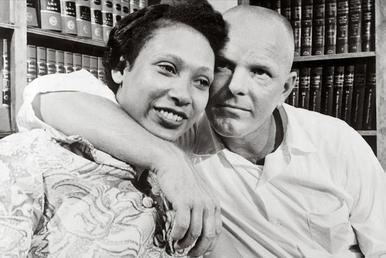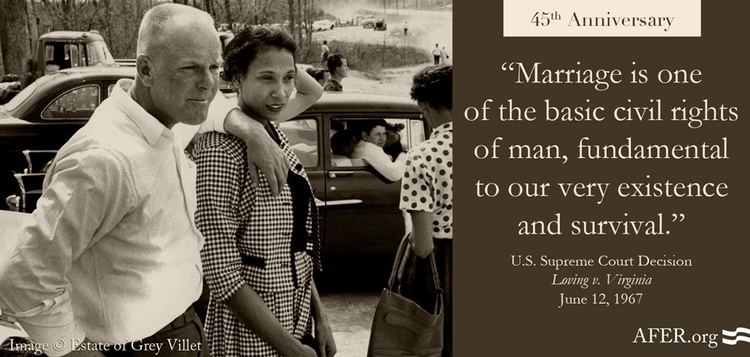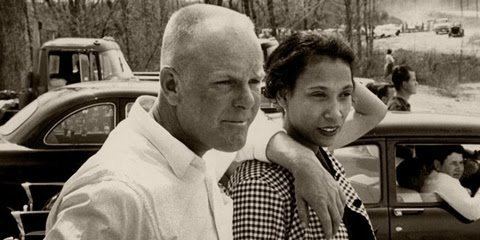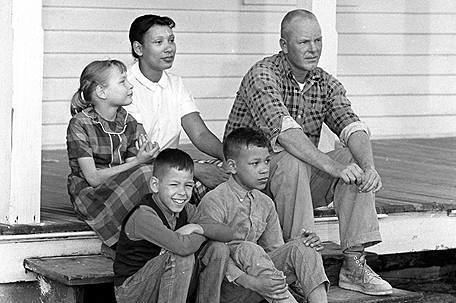Argument Oral argument End date 1967 | Concurrence Stewart | |
 | ||
Citations 388 U.S. 1 (more)87 S. Ct. 1817; 18 L. Ed. 2d 1010; 1967 U.S. LEXIS 1082 Prior history Defendants convicted, Caroline County Circuit Court (January 6, 1959); motion to vacate judgment denied, Caroline County Circuit Court (January 22, 1959); affirmed in part, reversed and remanded, 147 S.E.2d 78 (Va. 1966) Majority Warren, joined by unanimous Similar Lawrence v Texas, Brown v Board of Education, Griswold v Connecticut, Plessy v Ferguson, Obergefell v Hodges | ||
Loving v. Virginia, 388 U.S. 1 (1967), is a landmark civil rights decision of the United States Supreme Court, which invalidated laws prohibiting interracial marriage.
Contents
- Supreme court clips loving v virginia interracial marriage
- Background
- Plaintiffs
- Criminal proceedings
- Appellate proceedings
- Precedents
- Decision
- For interracial marriage
- For same sex marriage
- In popular culture
- References
The case was brought by Mildred Loving, a black woman, and Richard Loving, a white man, who had been sentenced to a year in prison in Virginia for marrying each other. Their marriage violated the state's anti-miscegenation statute, the Racial Integrity Act of 1924, which prohibited marriage between people classified as "white" and people classified as "colored". The Supreme Court's unanimous decision determined that this prohibition was unconstitutional, overruling Pace v. Alabama (1883) and ending all race-based legal restrictions on marriage in the United States.

The decision was followed by an increase in interracial marriages in the U.S., and is remembered annually on Loving Day, June 12. It has been the subject of several songs and three movies, including the acclaimed 2016 film Loving. Beginning in 2013, it was cited as precedent in U.S. federal court decisions holding restrictions on same-sex marriage in the United States unconstitutional, including in the 2015 Supreme Court decision Obergefell v. Hodges.

Supreme court clips loving v virginia interracial marriage
Background

Anti-miscegenation laws in the United States had been in place in certain states since colonial days. Marriage to a slave was never legal. In the Reconstruction Era in 1865 the Black Codes across the seven states of the lower South made intermarriage illegal. The new Republican legislatures in six states repealed the restrictive laws. After the Democrats returned to power, the restriction was reimposed.

A major concern was how to draw the line between black and white in a society in which white men had many children with black slave women. On the one hand, a person's reputation as black or white was usually decisive in practical matters. On the other hand, most laws used a "one drop of blood" rule, which meant that one black ancestor made a person black in the view of the law.
In 1967, 16 states, all Southern, had anti-miscegenation laws.
Plaintiffs

Mildred Delores Loving (née Jeter; July 22, 1939 – May 2, 2008) was the daughter of Musial (Byrd) Jeter and Theoliver Jeter. Her husband was Richard Perry Loving (October 29, 1933 – June 29, 1975), a white man, and the son of Lola (Allen) Loving and Twillie Loving. Mildred was African-American, and also had Cherokee and Rappahannock Native American ancestry. Her race has been a point of confusion – during the trial, it seemed clear that she identified herself as black, especially as far as her own lawyer was concerned. However, upon her arrest, the police report identifies her as “Indian.” She said in a 2004 interview, "I am not black." A factor contributing to the confusion is that it was seen at the time of her arrest as advantageous to be “anything but black.”
Richard Loving died aged 41 in 1975, when a drunk driver struck his car in Caroline County, Virginia. Mildred Loving lost her right eye in the same accident. She died of pneumonia on May 2, 2008, in Milford, Virginia, aged 68. The couple had three children: Donald, Peggy, and Sidney.
Criminal proceedings
At the age of 18, Mildred became pregnant; in June 1958, the couple traveled to Washington, D.C. to marry, thereby evading Virginia's Racial Integrity Act of 1924, which made marriage between whites and non-whites a crime. They returned to the small town of Central Point, Virginia. Based on an anonymous tip, local police raided their home in the early morning hours of July 11, 1958, hoping to find them having sex, which was also outlawed in Virginia. When the officers found the Lovings sleeping in their bed, Mildred pointed out their marriage certificate on the bedroom wall. They were told the certificate was not valid in the Commonwealth.
The Lovings were charged under Section 20-58 of the Virginia Code, which prohibited interracial couples from being married out of state and then returning to Virginia, and Section 20-59, which classified miscegenation as a felony, punishable by a prison sentence of between one and five years.
On January 6, 1959, the Lovings pled guilty to "cohabiting as man and wife, against the peace and dignity of the Commonwealth." They were sentenced to one year in prison, with the sentence suspended on condition that the couple leave Virginia and not return together for at least 25 years. After their conviction, the couple moved to the District of Columbia.
Appellate proceedings
In 1964, frustrated by their inability to travel together to visit their families in Virginia, as well as their social isolation and financial difficulties in Washington, Mildred Loving wrote in protest to Attorney General Robert F. Kennedy. Kennedy referred her to the American Civil Liberties Union (ACLU). The ACLU assigned volunteer cooperating attorneys Bernard S. Cohen and Philip J. Hirschkop, who filed a motion on behalf of the Lovings in the Virginia Caroline County Circuit Court, that requested the court to vacate the criminal judgments and set aside the Lovings' sentences on the grounds that the Virginia miscegenation statutes ran counter to the Fourteenth Amendment's Equal Protection Clause.
On October 28, 1964, after waiting almost a year for a response to their motion, the ACLU attorneys brought a class action suit in the U.S. District Court for the Eastern District of Virginia. This prompted the county court judge in the case, Leon M. Bazile, to issue a ruling on the long-pending motion to vacate. Echoing Johann Friedrich Blumenbach's 18th-century interpretation of race, the local court wrote:
Almighty God created the races white, black, yellow, malay and red, and he placed them on separate continents. And but for the interference with his arrangement there would be no cause for such marriages. The fact that he separated the races shows that he did not intend for the races to mix.
On January 22, 1965, a three-judge district court panel postponed decision on the federal class-action case while the Lovings appealed Judge Bazile's decision on constitutional grounds to the Virginia Supreme Court. Justice Harry L. Carrico (later Chief Justice of the Court) wrote an opinion for the court upholding the constitutionality of the anti-miscegenation statutes. While he upheld their criminal convictions, he directed that their sentence be modified. Carrico cited as authority the Virginia Supreme Court's decision in Naim v. Naim (1955) and argued that the Lovings' case was not a violation of the Equal Protection Clause because both the white and the non-white spouse were punished equally for the crime of miscegenation, an argument similar to that made by the United States Supreme Court in 1883 in Pace v. Alabama.
The Lovings, still supported by the ACLU, appealed the decision to the United States Supreme Court. They did not attend the oral arguments in Washington, but one of their lawyers, Bernard S. Cohen, conveyed the message he had been given by Richard Loving: "Mr. Cohen, tell the Court I love my wife, and it is just unfair that I can't live with her in Virginia."
Precedents
Before Loving v. Virginia, there had been several cases on the subject of interracial sexual relations. In Pace v. Alabama (1883), the Supreme Court ruled that the conviction of an Alabama couple for interracial sex, affirmed on appeal by the Alabama Supreme Court, did not violate the Fourteenth Amendment. Interracial marital sex was deemed a felony, whereas extramarital sex ("adultery or fornication") was only a misdemeanor. On appeal, the United States Supreme Court ruled that the criminalization of interracial sex was not a violation of the equal protection clause because whites and non-whites were punished in equal measure for the offense of engaging in interracial sex. The court did not need to affirm the constitutionality of the ban on interracial marriage that was also part of Alabama's anti-miscegenation law, since the plaintiff, Mr. Pace, had chosen not to appeal that section of the law. After Pace v. Alabama, the constitutionality of anti-miscegenation laws banning marriage and sex between whites and non-whites remained unchallenged until the 1920s.
In Kirby v. Kirby (1921), Mr. Kirby asked the state of Arizona for an annulment of his marriage. He charged that his marriage was invalid because his wife was of "negro" descent, thus violating the state's anti-miscegenation law. The Arizona Supreme Court judged Mrs. Kirby's race by observing her physical characteristics and determined that she was of mixed race, therefore granting Mr. Kirby's annulment.
In the Monks case (Estate of Monks, 4. Civ. 2835, Records of California Court of Appeals, Fourth district), the Superior Court of San Diego County in 1939 decided to invalidate the marriage of Marie Antoinette and Allan Monks because she was deemed to have "one eighth negro blood". The court case involved a legal challenge over the conflicting wills that had been left by the late Allan Monks; an old one in favor of a friend named Ida Lee, and a newer one in favor of his wife. Lee's lawyers charged that the marriage of the Monkses, which had taken place in Arizona, was invalid under Arizona state law because Marie Antoinette was "a Negro" and Alan had been white. Despite conflicting testimony by various expert witnesses, the judge defined Mrs. Monks' race by relying on the anatomical "expertise" of a surgeon. The judge ignored the arguments of an anthropologist and a biologist that it was impossible to tell a person's race from physical characteristics.
Monks then challenged the Arizona anti-miscegenation law itself, taking her case to the California Court of Appeals, Fourth District. Monks' lawyers pointed out that the anti-miscegenation law effectively prohibited Monks as a mixed-race person from marrying anyone: "As such, she is prohibited from marrying a negro or any descendant of a negro, a Mongolian or an Indian, a Malay or a Hindu, or any descendants of any of them. Likewise ... as a descendant of a negro she is prohibited from marrying a Caucasian or a descendant of a Caucasian...." The Arizona anti-miscegenation statute thus prohibited Monks from contracting a valid marriage in Arizona, and was therefore an unconstitutional constraint on her liberty. However, the court dismissed this argument as inapplicable, because the case presented involved not two mixed-race spouses but a mixed-race and a white spouse: "Under the facts presented the appellant does not have the benefit of assailing the validity of the statute." Dismissing Monks' appeal in 1942, the United States Supreme Court refused to reopen the issue.
The turning point came with Perez v. Sharp (1948), also known as Perez v. Lippold. In Perez, the Supreme Court of California recognized that bans on interracial marriage violated the Fourteenth Amendment of the Federal Constitution.
Decision
The U.S. Supreme Court overturned the Lovings' convictions in a unanimous decision dated June 12, 1967, dismissing the Commonwealth of Virginia's argument that a law forbidding both white and black persons from marrying persons of another race and providing identical penalties to white and black violators could not be construed as racially discriminatory. The court ruled that Virginia's anti-miscegenation statute violated both the Due Process Clause and the Equal Protection Clause of the Fourteenth Amendment.
Chief Justice Earl Warren's opinion for the unanimous court held that:
Marriage is one of the "basic civil rights of man," fundamental to our very existence and survival.... To deny this fundamental freedom on so unsupportable a basis as the racial classifications embodied in these statutes, classifications so directly subversive of the principle of equality at the heart of the Fourteenth Amendment, is surely to deprive all the State's citizens of liberty without due process of law. The Fourteenth Amendment requires that the freedom of choice to marry not be restricted by invidious racial discrimination. Under our Constitution, the freedom to marry, or not marry, a person of another race resides with the individual and cannot be infringed by the State.
The court concluded that anti-miscegenation laws were racist and had been enacted to perpetuate white supremacy:
There is patently no legitimate overriding purpose independent of invidious racial discrimination which justifies this classification. The fact that Virginia prohibits only interracial marriages involving white persons demonstrates that the racial classifications must stand on their own justification, as measures designed to maintain White Supremacy.
Associate Justice Potter Stewart filed a brief concurring opinion. He reiterated his opinion from McLaughlin v. Florida that "it is simply not possible for a state law to be valid under our Constitution which makes the criminality of an act depend upon the race of the actor."
For interracial marriage
Despite the Supreme Court's decision, anti-miscegenation laws remained on the books in several states, although the decision had made them unenforceable. Local judges in Alabama continued to enforce that state's anti-miscegenation statute until the Nixon administration obtained a ruling from a U.S. District Court in United States v. Brittain in 1970. In 2000, Alabama became the last state to adapt its laws to the Supreme Court's decision, when 60% of voters endorsed a ballot initiative that removed anti-miscegenation language from the state constitution.
After Loving v. Virginia, the number of interracial marriages continued to increase across the United States and in the South. In Georgia, for instance, the number of interracial marriages increased from 21 in 1967 to 115 in 1970. At the national level, 0.4% of marriages were interracial in 1960, 2.0% in 1980, and 12% in 2013.
For same-sex marriage
Loving v. Virginia was discussed in the context of the public debate about same-sex marriage in the United States.
In Hernandez v. Robles (2006), the majority opinion of the New York Court of Appeals—that state's highest court—declined to rely on the Loving case when deciding whether a right to same-sex marriage existed, holding that "the historical background of Loving is different from the history underlying this case." In the 2010 federal district court decision in Perry v. Schwarzenegger, overturning California's Proposition 8 which restricted marriage to opposite-sex couples, Judge Vaughn R. Walker cited Loving v. Virginia to conclude that "the [constitutional] right to marry protects an individual's choice of marital partner regardless of gender". On more narrow grounds, the 9th Circuit Court of Appeals affirmed.
In June 2007, on the 40th anniversary of the Supreme Court's decision in Loving, Mildred Loving issued a statement that said:
I believe all Americans, no matter their race, no matter their sex, no matter their sexual orientation, should have that same freedom to marry... I am still not a political person, but I am proud that Richard's and my name is on a court case that can help reinforce the love, the commitment, the fairness and the family that so many people, black or white, young or old, gay or straight, seek in life. I support the freedom to marry for all. That's what Loving, and loving, are all about.
Up until 2014, five U.S. Courts of Appeals considered the constitutionality of state bans on same-sex marriage. In doing so they interpreted or used the Loving ruling differently:
In Obergefell v. Hodges (2015), which decided the issue, the Supreme Court invoked Loving, among other cases, as precedent for its holding that states are required to allow same-sex marriages under both the Equal Protection Clause and the Due Process Clause of the Constitution. The court's decision in Obergefell cited Loving nearly a dozen times, and was based on the same principles – equality and an unenumerated right to marriage. During oral argument, the eventual author of the majority opinion, Justice Anthony Kennedy, noted that the decisions holding racial segregation and bans on interracial marriage unconstitutional (Brown v. Board of Education and Loving, respectively), were made about 13 years apart, much like the decision prohibiting bans on same-sex sexual activity (Lawrence v. Texas) and Obergefell.
In popular culture
In the United States, June 12, the date of the decision, has become known as Loving Day, an annual unofficial celebration of interracial marriages. In 2014, Mildred Loving was honored as one of the Library of Virginia's "Virginia Women in History".
The story of the Lovings became the basis of several films:
A 2015 novel by the French journalist Gilles Biassette, L'amour des Loving ("The Love of the Lovings", ISBN 978-2917559598), recounts the life of the Lovings and their case.
